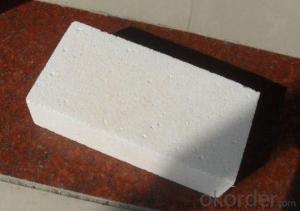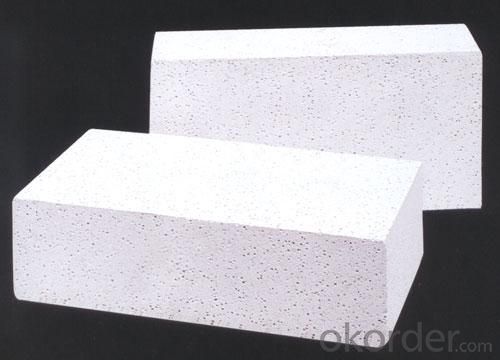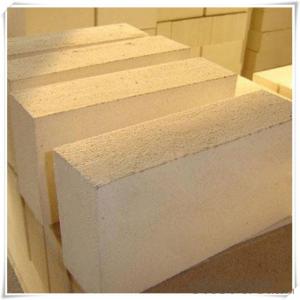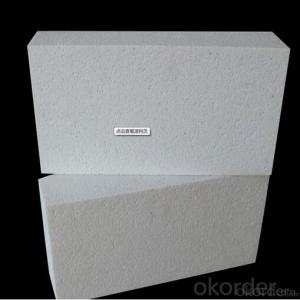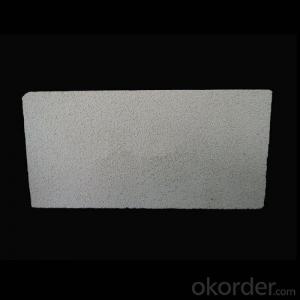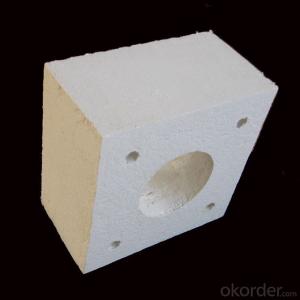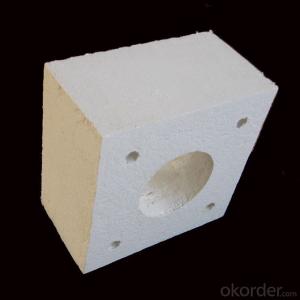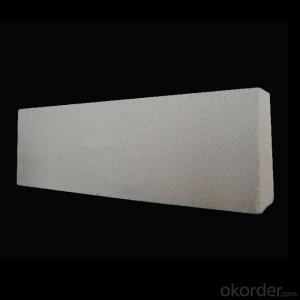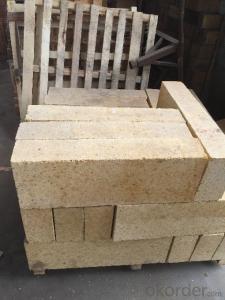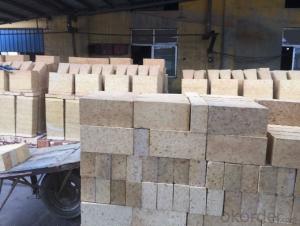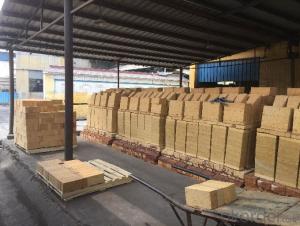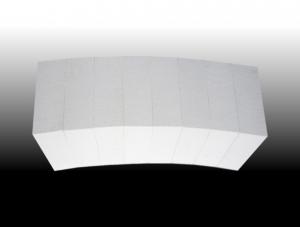Insulating Fire Brick 65% Al2O3 Min High Alumina
- Loading Port:
- Shanghai
- Payment Terms:
- TT OR LC
- Min Order Qty:
- 500 m.t.
- Supply Capability:
- 1000 m.t./month
OKorder Service Pledge
OKorder Financial Service
You Might Also Like
Specifications
1.65% Al2O3 min;
2. Refractoriness: 1790C min;
3.For steelmaking furnaces;
4.ISO 9001 Certificate;
5.Custom shape.
High alumina insulating fire brick is a kind of insulation material adopting organic matter as ignition loss substance in order to increase the porosity of refractory, which has such advantages as high porosity, small volume density, good insulation effect, high mechanical intensity, small thermal conductivity and long service life. For various industrial kilns & furnaces, it is a kind of essential refractory for energy saving and temperature preservation.
This series of High Alumina Insulating Fire Brick are made of selected high alumina bauxite, kaolin caly, hollow microsphere as the mian material.By shaping at high pressure and sintering at high temperature.
| Items | Mark | ||||||
Hihg Alumina brick | Clay brick | Phosphoric acid dipping clay brick | |||||
| GL-65 | GL- 55 | GL- 48 | ZGN-42 | ZGN-42 | |||
| Chemical Compositions ( %) ≥ | Al2O3 | 65 | 55 | 48 | 42 | 42 | |
| Fe2O3 | 2.0 | 2.0 | 2.0 | 1.6 | 1.7 | ||
| P2O5 | - | - | - | - | - | 7 | |
| Refractoriness ℃ | 1790 | 1770 | 1750 | 1750 | 1750 | - | |
| Apparent Porosity (%)≤ | 19 | 19 | 18 | 15 | 16 | 14 | |
| Alkali resistance (strength degradation)%≤ | - | - | - | - | - | 15 | |
| 0.2MPaRefractoriness under load,℃≥ | 1500 | 1480 | 1450 | 1450 | 1430 | 1450 | |
| CCS (Mpa)≥ | 58.8 | 49 | 49 | 58.8 | 49 | 60 | |
| Dead burnt linear change(%)≤ | 1450℃×2h | 0/-0.2 | 0/-0.2 | 0/-0.3 | 0/-0.2 | ||
| 1500℃×2h | 0/-0.2 | ||||||
Starting from the raw material into factory, Every production process of high alumina insulating fire bricks should through strict quality control, both the raw materials and finished products should be inspected time after time, to esure that each product to satisfy our customers, because of advanced automatic batching system and 2500 tons automatic hydraulic machine in the world were introduced, then a new line of the ladle fire bricks and other styling refractory products with a superior quality was put into production.
- Q: Can insulating fire bricks be used in the construction of smelter crucibles?
- Yes, insulating fire bricks can be used in the construction of smelter crucibles. Insulating fire bricks are made from materials that can withstand high temperatures, making them suitable for use in smelting operations. These bricks have low thermal conductivity, which helps to retain heat and prevent excessive heat loss from the smelter crucible. This makes them ideal for creating a well-insulated and efficient crucible that can withstand the intense heat and thermal shock associated with smelting processes. Additionally, insulating fire bricks are lightweight and easy to shape, allowing for convenient construction and customization of the crucible design. Overall, using insulating fire bricks in the construction of smelter crucibles can help to improve the thermal efficiency and durability of the crucible, leading to more efficient and effective smelting operations.
- Q: Can insulating fire bricks be used as a backup insulation in refractory linings?
- Yes, insulating fire bricks can be used as a backup insulation in refractory linings. They are designed to withstand high temperatures and provide excellent thermal insulation properties, making them suitable for this purpose.
- Q: What is the porosity of insulating fire bricks?
- The porosity of insulating fire bricks refers to the amount of open space or voids within the material. Insulating fire bricks are designed to have a high porosity, typically ranging from 50% to 80%. This high porosity allows for excellent thermal insulation properties by trapping air or other insulating gases within the voids. The air pockets serve as barriers for heat transfer, reducing the conduction of thermal energy through the bricks. As a result, insulating fire bricks are highly effective in maintaining high temperatures within industrial furnaces, kilns, or other high-temperature applications while minimizing heat loss. The specific porosity of insulating fire bricks can vary depending on the manufacturing process and the desired level of insulation required for a particular application.
- Q: Are insulating fire bricks suitable for insulation in refinery heaters?
- Yes, insulating fire bricks are suitable for insulation in refinery heaters. Refinery heaters operate at extremely high temperatures, and insulating fire bricks are designed to withstand these temperatures and provide effective insulation. These bricks have low thermal conductivity, which means they can prevent heat from escaping the heater, thus reducing energy loss and increasing the overall efficiency of the heater. Additionally, insulating fire bricks have excellent thermal shock resistance, meaning they can withstand rapid temperature changes without cracking or breaking. This is crucial in refinery heaters, as they often experience frequent temperature fluctuations during operation. Furthermore, insulating fire bricks are lightweight and easy to install, making them a convenient choice for insulation in refinery heaters. Overall, insulating fire bricks are a suitable and effective option for insulation in refinery heaters.
- Q: Can insulating fire bricks be used in the construction of refractory linings?
- Yes, insulating fire bricks can be used in the construction of refractory linings. Insulating fire bricks have excellent thermal insulation properties, low thermal conductivity, and high refractoriness, making them suitable for applications where heat retention and energy efficiency are important. They are commonly used in industries such as steel, ceramics, glass, and cement to line kilns, furnaces, and other high-temperature equipment.
- Q: Can insulating fire bricks be used for insulation in residential walls?
- Insulating fire bricks are primarily designed for high-temperature applications, such as in kilns or furnaces. While they do provide excellent insulation properties, they are not typically recommended for use in residential walls. The reason is that insulating fire bricks may not meet the specific building codes and regulations required for residential construction. Additionally, there are other insulation materials available that are better suited for residential walls, such as fiberglass or foam insulation, which are more cost-effective and easier to install.
- Q: Can insulating fire bricks be used for insulation in hot blast stoves?
- Insulating fire bricks are suitable for insulation in hot blast stoves due to their ability to withstand high temperatures and provide excellent thermal insulation. These bricks are constructed using lightweight materials with low thermal conductivity, enabling them to effectively retain heat and prevent heat transfer to the surrounding environment. By incorporating insulating fire bricks in hot blast stoves, the internal temperatures can be preserved at high levels while minimizing heat loss. As a result, the stove's energy efficiency is enhanced, and the structure is safeguarded from excessive heat. Consequently, the practice of using insulating fire bricks for insulation in hot blast stoves is widely adopted and proven to be effective.
- Q: Can insulating fire bricks be used in rotary kilns?
- Rotary kilns can indeed utilize insulating fire bricks. These bricks are specifically designed to possess low thermal conductivity, enabling them to withstand high temperatures while minimizing heat loss. Consequently, they are well-suited for employment in rotary kilns, which are utilized across various industries for processes like calcination, sintering, and roasting. The application of insulating fire bricks within rotary kilns effectively contains the internally generated heat, resulting in enhanced energy efficiency and cost savings. Moreover, these bricks' insulating properties aid in reducing the temperature on the kiln's outer surface, thereby ensuring a safer working environment for operators. Ultimately, insulating fire bricks serve as an ideal choice for rotary kilns, offering remarkable thermal insulation and contributing to the kiln's overall performance and durability.
- Q: Can insulating fire bricks be used in wastewater treatment plants?
- Indeed, insulating fire bricks have the capability to be utilized within wastewater treatment plants. Specifically engineered to endure extreme temperatures, insulating fire bricks are fitting for a variety of industrial applications, including wastewater treatment plants. They are commonly implemented in constructing kilns, furnaces, and other equipment that operates at high temperatures. Within wastewater treatment plants, insulating fire bricks can be incorporated into the assembly of incinerators, thermal oxidizers, and other systems that necessitate high-temperature insulation. Their exceptional properties, such as remarkable thermal resistance, minimal thermal conductivity, and exceptional insulation abilities, make them an ideal choice for maintaining the desired temperatures in these systems while simultaneously diminishing heat loss. Moreover, insulating fire bricks demonstrate resistance to chemical attacks, a vital characteristic within wastewater treatment plants that handle a plethora of chemicals and corrosive substances. In summary, the utilization of insulating fire bricks in wastewater treatment plants can lead to enhanced energy efficiency, reduced maintenance expenses, and the assurance of longevity for high-temperature equipment.
- Q: How do insulating fire bricks affect the overall fire rating of a structure?
- The overall fire rating of a structure is greatly influenced by the use of insulating fire bricks. These bricks are specifically designed to provide effective thermal insulation, thus reducing heat transfer and the risk of fire propagation. Incorporating insulating fire bricks into the construction of walls, ceilings, and floors significantly enhances the structural integrity of the building. The insulating properties of these bricks limit the spread of fire by reducing heat conduction through building materials. This is achieved through the presence of tiny air pockets within the bricks that act as insulating barriers. As a result, the temperature rise on the non-exposed side of the wall or floor is minimized, preventing the rapid spread of fire to other areas of the structure. In addition to their thermal insulation capabilities, insulating fire bricks are also highly resistant to high temperatures. This allows them to maintain their structural integrity even when exposed to intense heat, making them highly resistant to fire damage. Using these bricks in critical areas such as fire-rated walls, doors, and fireplaces significantly improves the overall fire rating of a structure. Furthermore, insulating fire bricks offer additional benefits such as soundproofing, energy efficiency, and durability. They reduce sound transmission, creating a quieter environment inside the structure. Their excellent insulation properties also minimize heat loss or gain, resulting in lower heating and cooling costs. Additionally, their resistance to thermal shock and chemical corrosion ensures a long-lasting and reliable fire barrier. To conclude, insulating fire bricks play a crucial role in enhancing the overall fire rating of a structure. Their exceptional thermal insulation properties and ability to withstand high temperatures contribute to preventing the rapid spread of fire and minimizing fire damage. Incorporating these bricks into the construction of walls, ceilings, and floors significantly improves the fire safety of a building, providing occupants with valuable evacuation time and minimizing property loss.
Send your message to us
Insulating Fire Brick 65% Al2O3 Min High Alumina
- Loading Port:
- Shanghai
- Payment Terms:
- TT OR LC
- Min Order Qty:
- 500 m.t.
- Supply Capability:
- 1000 m.t./month
OKorder Service Pledge
OKorder Financial Service
Similar products
Hot products
Hot Searches
Related keywords
